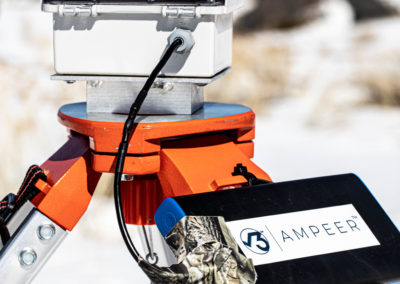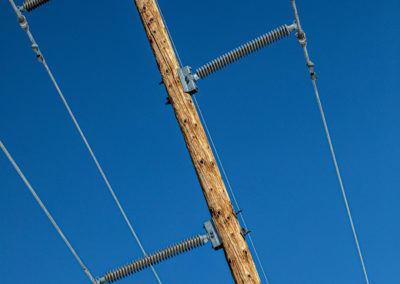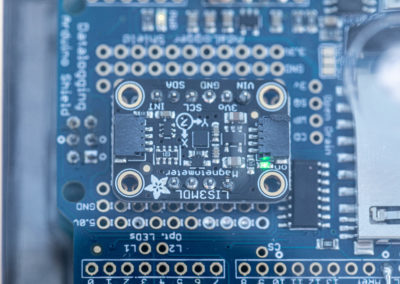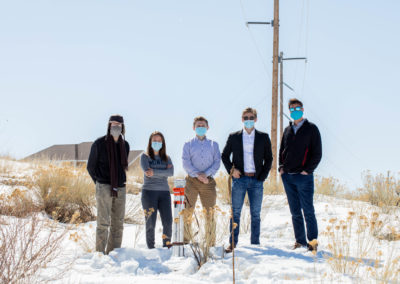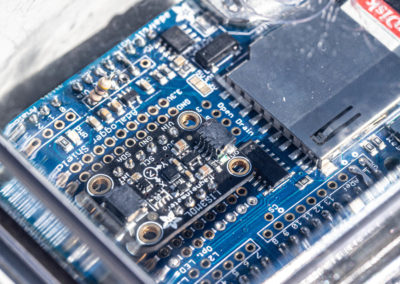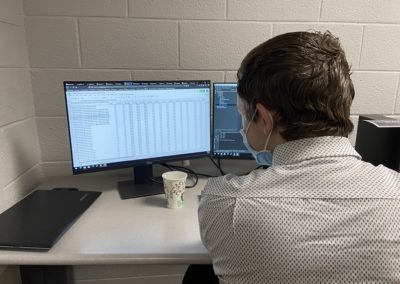Ampeer Transmission Line Loading Measurement Device
(SECOND PLACE OVERALL)
Overview
Induced voltage is a problem for pipelines in the vicinity of transmission lines. Given that the value of this induced voltage is critical for equipment integrity and can be the difference between a slight shock and injury, being able to mitigate these voltages is absolutely critical for equipment integrity and public safety. This problem depends heavily on the currents traveling through the transmission line, but oftentimes an accurate picture of the loading on the line is difficult to obtain from the utility for a variety of reasons, which casts a shadow of doubt on resulting models.
The goal of this project is to passively measure loading conditions on overhead transmission lines over time accurately, then be able to monitor that data in real time from a computer. Using the device can be reduced to simply setting it up on a surveying tripod and plugging in the power. The device has a preloaded code which automatically runs and begins logging data to the SD card as soon as it receives power.
After validation through extensive field testing, this tool can be used at any site with any number of transmission line configurations, eliminating the uncertainty that is often a factor when using utility data and modeling techniques.
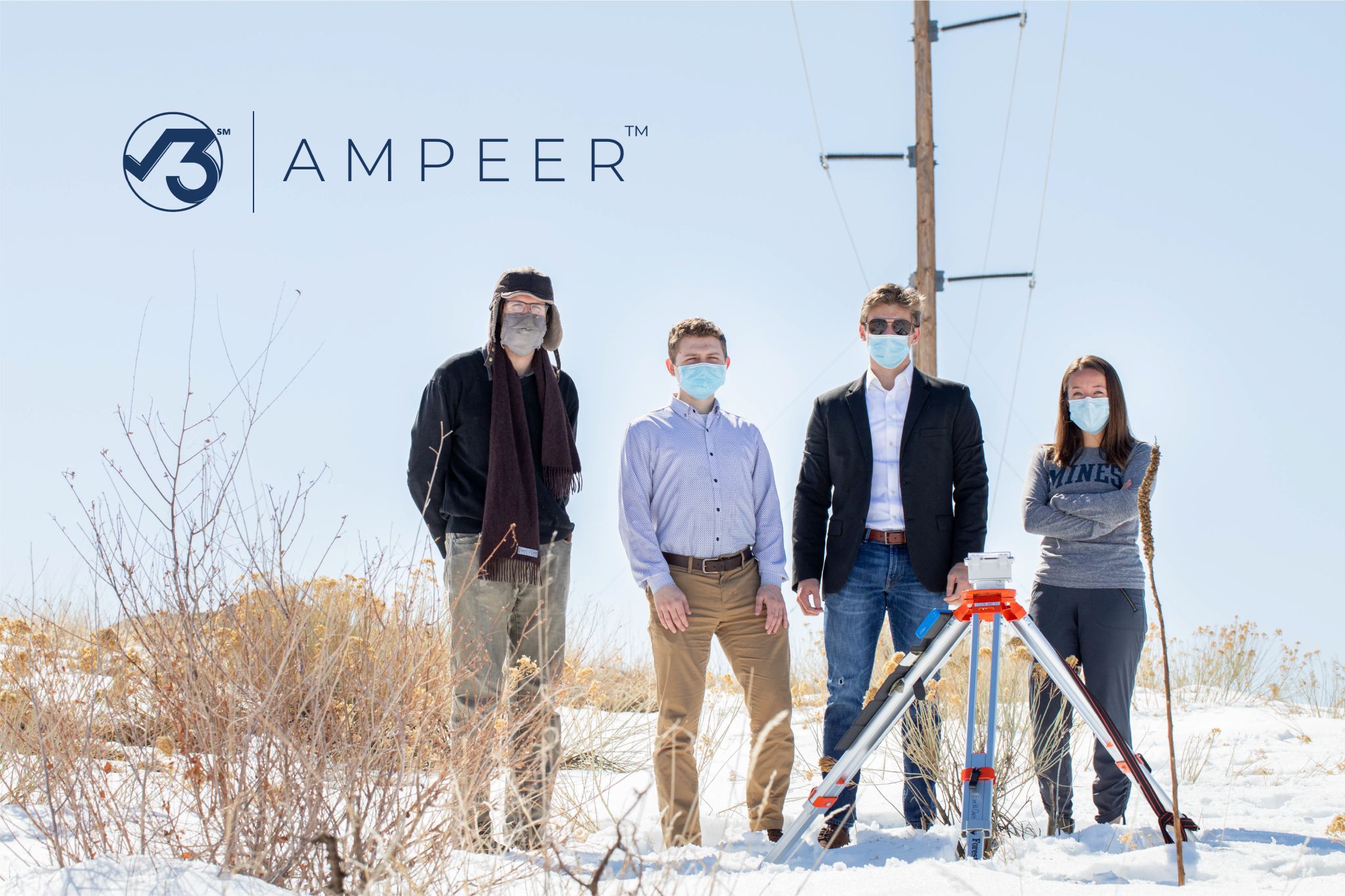
Live Zoom Chat
Use the link below to join us live from 8:00 – 10:30 a.m. on April 29.
https://mines.zoom.us/j/97951377208?pwd=MkRxK1NmWjl1WXVvZXpjQ0t4Y3hJZz09
Please Use Passcode: Ampeer
Or iPhone one-tap: 16699006833,97951377208# or 12532158782,97951377208#
Or Telephone:
Dial: +1 669 900 6833 (US Toll) or +1 253 215 8782 (US Toll)
Meeting ID: 979 5137 7208
International numbers available: https://mines.zoom.us/u/aUfVTGYk
Team Members
- Jaden Ranzenberger
- Lydia Manone
- Cyrus Boushehri
- Jacob Hoffer
The Client
- SR3 Engineering
Acknowledgements
Project Advisor: Donna Bodeau
Technical Advisor: Giancarlo Leone
Photographer: Dennis Kastsianok
Field Testing Coordinator: Mark Jurgemeyer
The team put a relentless focus early in the project on the building and iteration of a prototype, and had a preliminary device capable of measuring 3 axis magnetic field with an sensitivity of 150nT within the first couple months. The product specifications for this prototype, prototype 1, can be found below:

After building this prototype, the team took a step back to define more clearly what a properly designed device would mean and constructed a specifications sheet of an ideal device to target for the remainder for the project. This sheet can be found below:
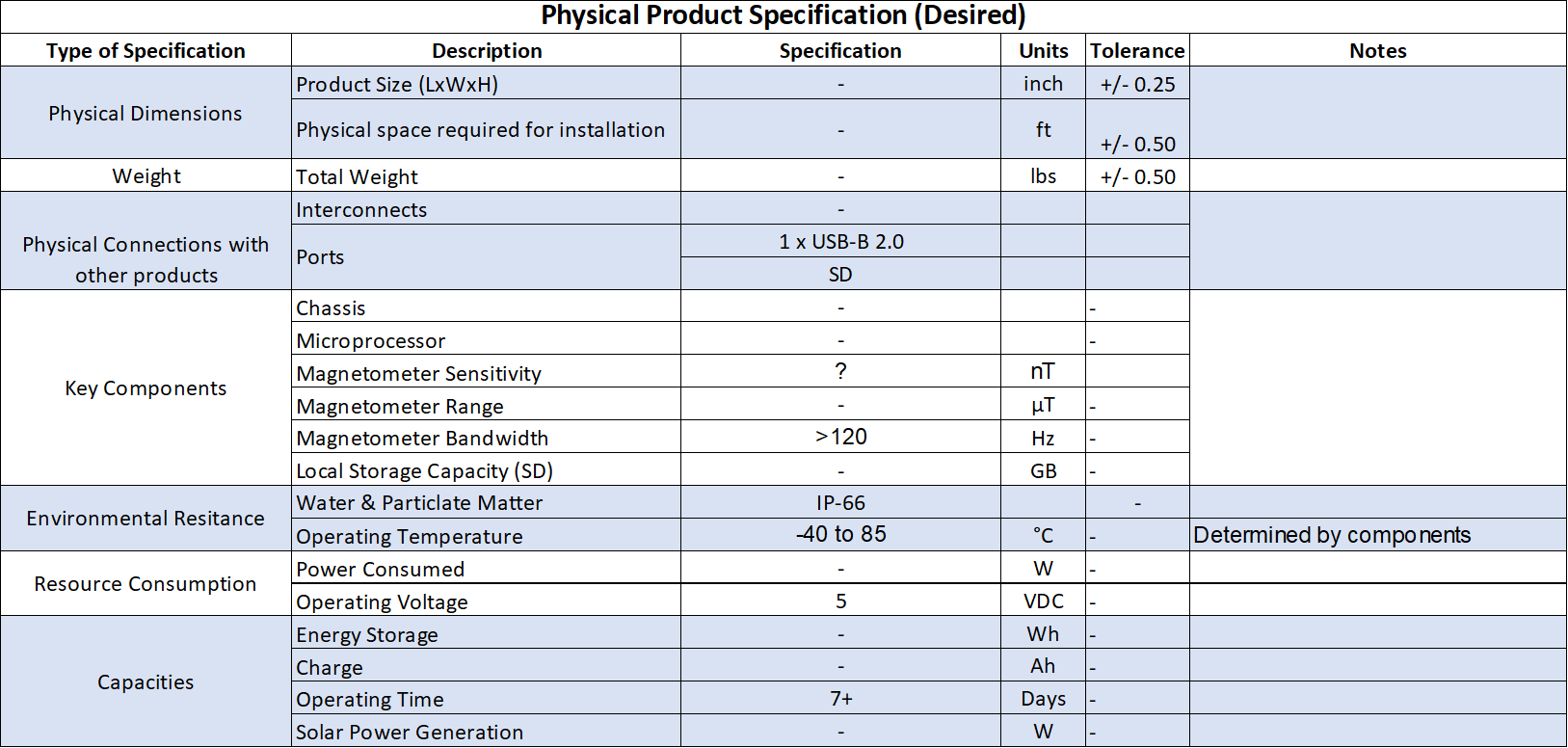
The team was then able to iterate and complete a second prototype (V2) which was then moved to the testing phase. Testing of the device included both field and laboratory testing. The field testing consisted of placing the device in the field for 7 days and recording continuous data which was then compared to actual data acquired from a local utility. V2 was able to record data for 4.5 days until the power ran out, this issue was fixed in prototype 3 (V3). Field testing consisted of magnetic field simulation along with sensitivity testing to ensure the device would operate efficiently in the field. The product specifications for V2 can be found below:

In the final months of the project the team completed a second iteration of the device to produce V3. This prototype has not been tested in the field; however, through laboratory simulation and testing the device is predicted to measure data for at least 7 days in the field.
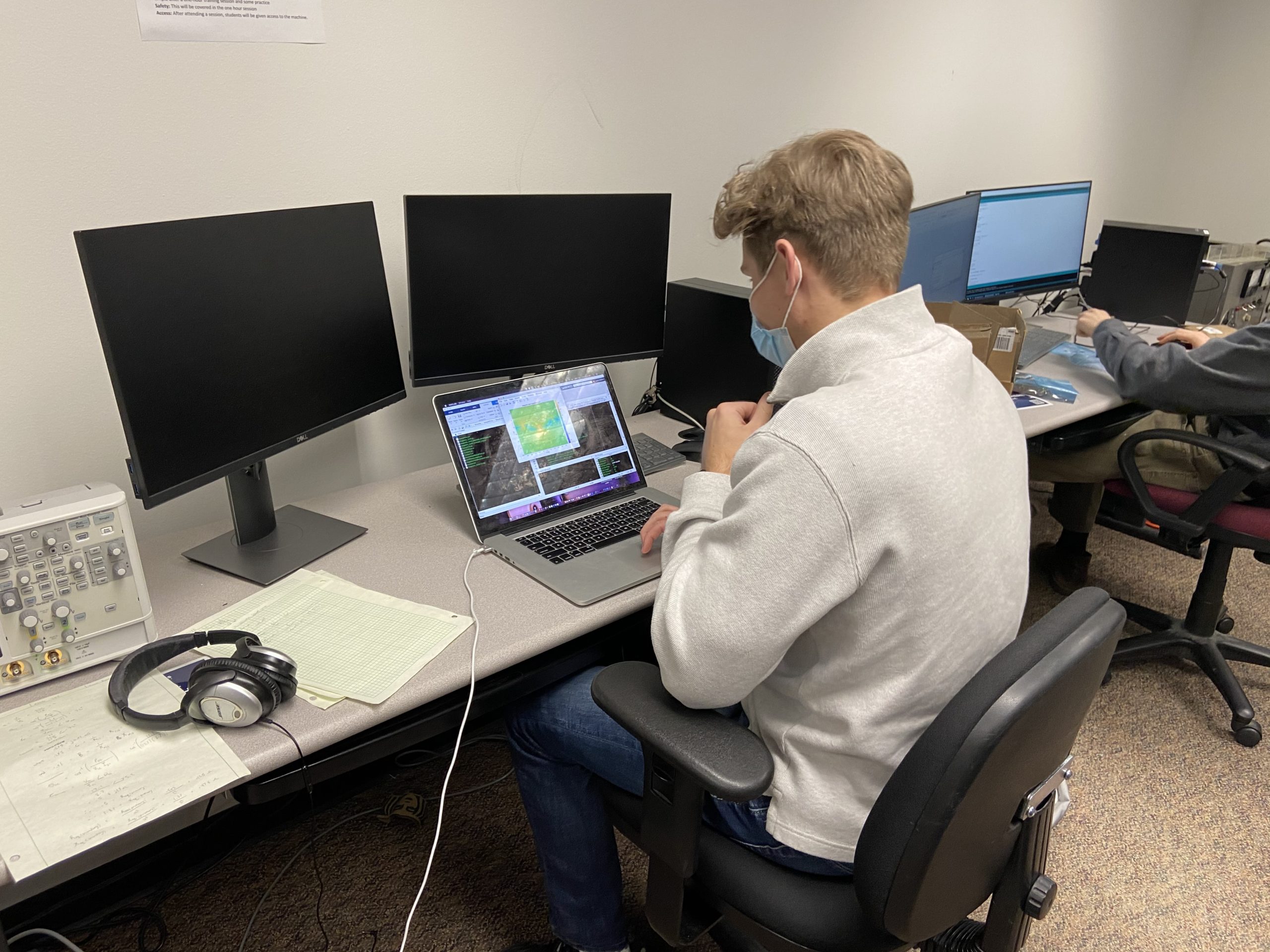
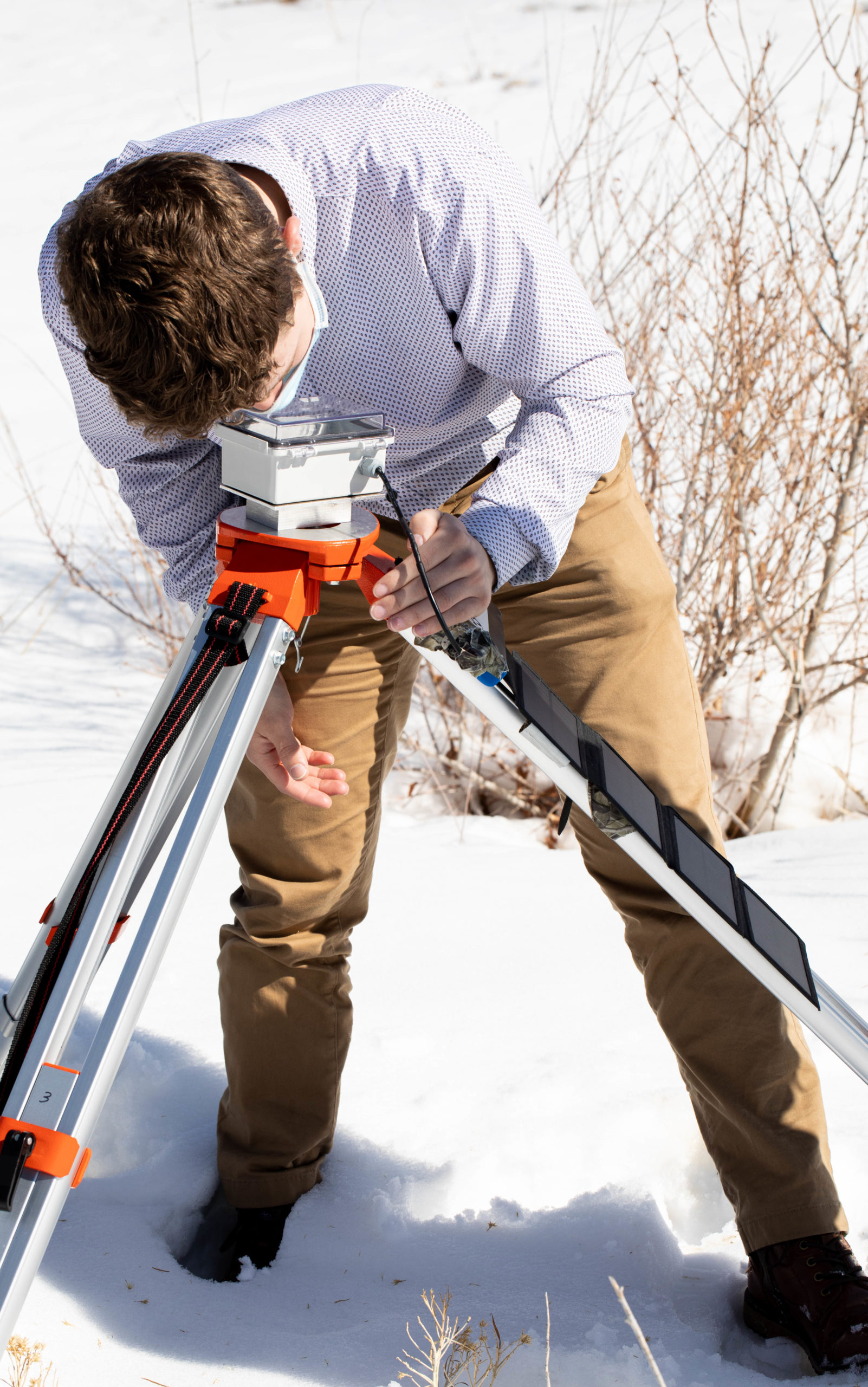
Design Solution
The proposed design, referred to as Prototype 3 (V3), has the following included components: a waterproof case, Arduino Mega, LIS3MDL magnetometer, a SD card reader shield and SD card, and a 40 amp hour battery. Inside the waterproof case is the Ampeer device itself, which consists of the Arduino Mega that has a SD card shield attached. On the SD card shield, there are additional thru holes which were used to solder the magnetometer to.
Also on the SD card shield is a Real Time Clock (RTC) which has a backup battery. The RTC allows the device to measure time with respect to a universal time reference, meaning that we can differentiate the data reported from the device by date and time more effectively (not in reference to the start time of the device).
The waterproof case will be mounted upon a surveying tripod. The surveying tripod has feet with spikes to secure it to the ground and prevent it from blowing over in winds. The battery is housed in a waterproof case that is mounted to a tripod leg, and the solar panel will stand alone and be oriented towards the sun upon installation. The exact specifications for the Ampeer device can be found below. Values marked with an asterisk (*) have been validated in the lab but not in the field.
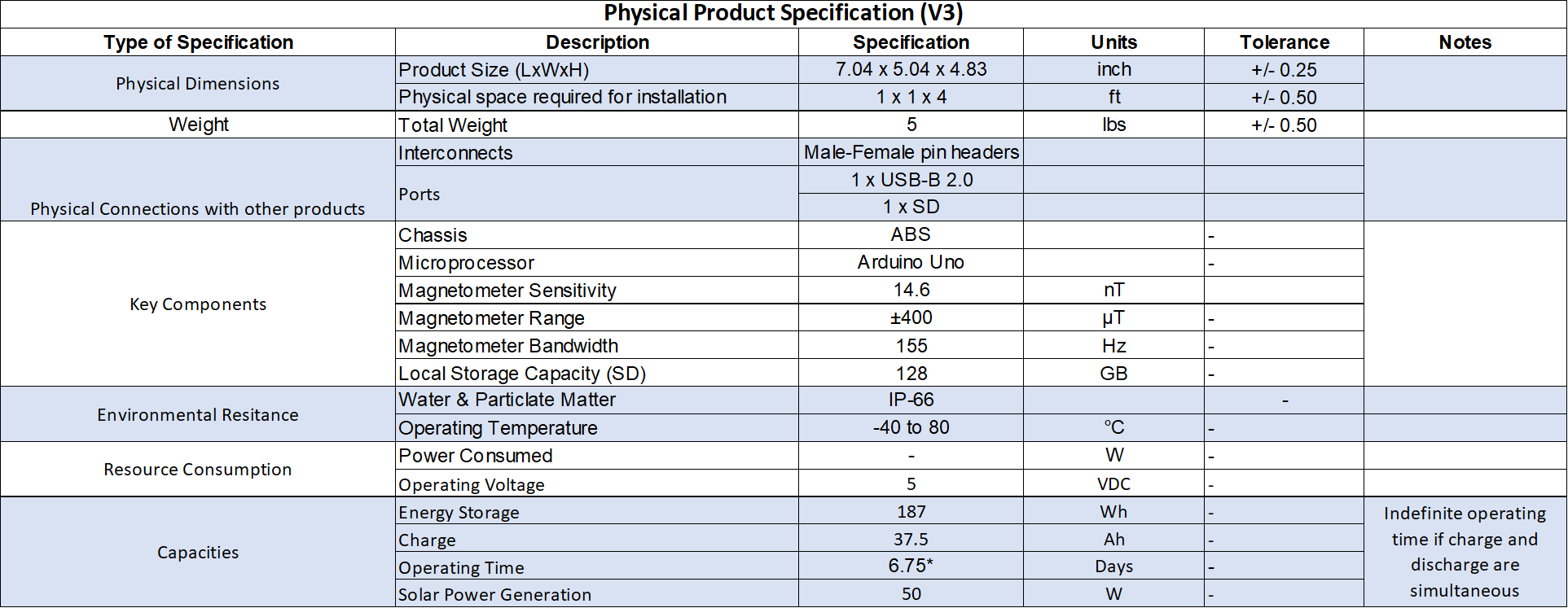
Next Steps
Next steps for the Ampeer device include:
- Signal post-processing for the automatic isolation of transmission line magnetic fields and transmission loading calculations
- Cellular data transmission for access from a computer in any location
- Field testing validation using HIFREQ and Matlab simulations which use the real world conditions of the testing
- Sampling rate and sensitivity verification simulations in Matlab to confirm the accuracy of the device in controlled conditions
- Intuitive data processing interface
At the conclusion of this project, the device will be transferred to the project client, SR3 Engineering, for further product development and proof of concept.
Meet the Team
Jaden Ranzenberger
 Jaden Ranzenberger will be graduating in May 2022 with a B.S. in Electrical Engineering. Jaden acted as project lead for the Ampeer team. His primary tasks included building the physical Ampeer device, developing the code used to run the device, and big picture planning for the devices use. Jaden also played a major role in bringing this project to the Mines Capstone program.
Jaden Ranzenberger will be graduating in May 2022 with a B.S. in Electrical Engineering. Jaden acted as project lead for the Ampeer team. His primary tasks included building the physical Ampeer device, developing the code used to run the device, and big picture planning for the devices use. Jaden also played a major role in bringing this project to the Mines Capstone program.
Lydia Manone

Lydia Manone is a graduating senior who will receive her B.S. in Environmental Engineering in May 2021. Lydia acted as project manager and client communication lead for the Ampeer team. Her primary tasks included client communication, project management through Zoho Projects, and visuals development. She also determined the Ampeer team name.
Jacob Hoffer
 Jacob Hoffer is a graduating senior who will receive his B.S. in Electrical Engineering in May 2021. Jacob’s project tasks included code development, testing simulation, and physical device development. His main focus was on developing the Matlab code used for testing and simulation on the Ampeer device.
Jacob Hoffer is a graduating senior who will receive his B.S. in Electrical Engineering in May 2021. Jacob’s project tasks included code development, testing simulation, and physical device development. His main focus was on developing the Matlab code used for testing and simulation on the Ampeer device.
Cyrus Boushehri
 Cyrus is a graduating senior who will be receiving his B.S. in Electrical engineering in May 2021. Cyrus’s project tasks included testing and simulation, device assembly, and physical device development. Cyrus lead the physical assembly of the Ampeer device along with conducting extensive tests on the device in the lab.
Cyrus is a graduating senior who will be receiving his B.S. in Electrical engineering in May 2021. Cyrus’s project tasks included testing and simulation, device assembly, and physical device development. Cyrus lead the physical assembly of the Ampeer device along with conducting extensive tests on the device in the lab.

